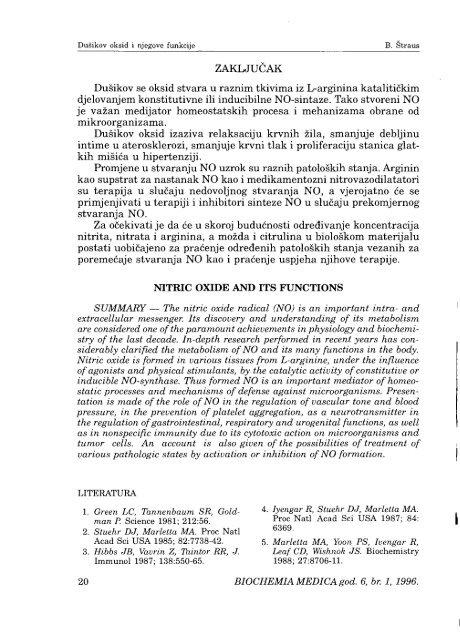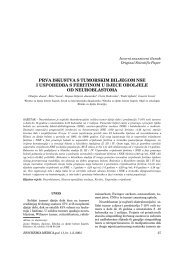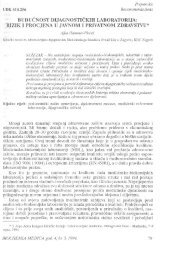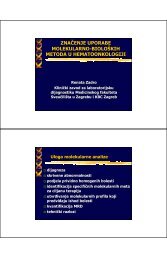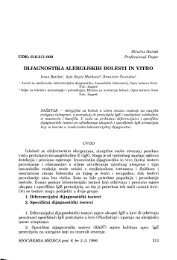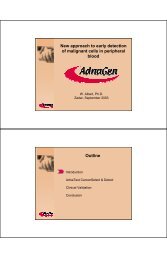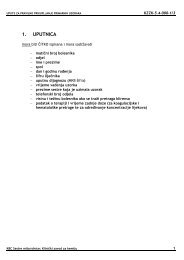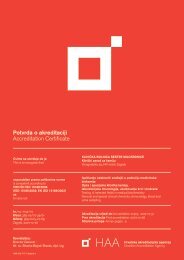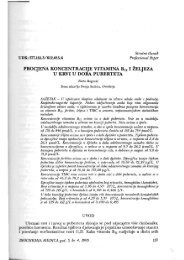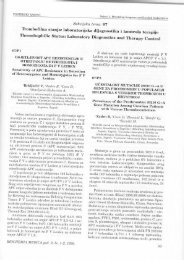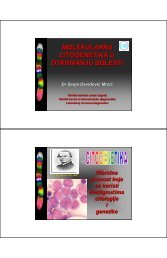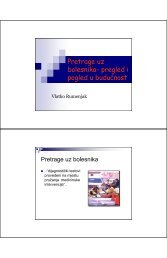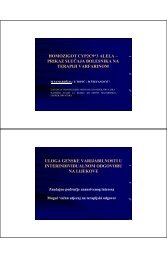You also want an ePaper? Increase the reach of your titles
YUMPU automatically turns print PDFs into web optimized ePapers that Google loves.
Dušikov <strong>oksid</strong> i <strong>njegove</strong> <strong>funkcije</strong> B. Straus<br />
ZAKLJUČAK<br />
Dušikov se <strong>oksid</strong> stvara u raznim tkivima iz L-arginina katalitičkim<br />
djelovanjem konstitutivne ili inducibilne NO-sintaze. Tako stvoreni NO<br />
je važan medijator homeostatskih procesa i mehanizama obrane od<br />
mikroorganizama.<br />
Dušikov <strong>oksid</strong> izaziva relaksaciju krvnih žila, smanjuje debljinu<br />
intime u aterosklerozi, smanjuje krvni tlak i proliferaciju stanica glatkih<br />
mišića u hipertenziji.<br />
Promjene u stvaranju NO uzrok su raznih patoloških stanja. Arginin<br />
kao supstrat za nastanak NO kao i medikamentozni nitrovazodilatatori<br />
su terapija u slučaju nedovoljnog stvaranja NO, a vjerojatno će se<br />
primjenjivati u terapiji i inhibitori sinteze NO u slučaju prekomjernog<br />
stvaranja NO.<br />
Za očekivati je da će u skoroj budućnosti određivanje koncentracija<br />
nitrita, nitrata i arginina, a možda i citrulina u biološkom materijalu<br />
postati uobičajeno za praćenje određenih patoloških stanja vezanih za<br />
poremećaje stvaranja NO kao i praćenje uspjeha njihove terapije.<br />
NITRIC OXIDE AND ITS FUNCTIONS<br />
SUMMARY — The nitric oxide radical (NO) is an important intra- and<br />
extracellular messenger. Its discovery and understanding of its metabolism<br />
are considered one of the paramount achievements in physiology and biochemistry<br />
of the last decade. In-depth research performed in recent years has considerably<br />
clarified the metabolism of NO and its many functions in the body.<br />
Nitric oxide is formed in various tissues from L-arginine, under the influence<br />
of agonists and physical stimulants, by the catalytic activity of constitutive or<br />
inducible NO-synthase. Thus formed NO is an important mediator of homeostatic<br />
processes and mechanisms of defense against microorganisms. Presentation<br />
is made of the role of NO in the regulation of vascular tone and blood<br />
pressure, in the prevention of platelet aggregation, as a neurotransmitter in<br />
the regulation of gastrointestinal, respiratory and urogenital functions, as ivell<br />
as in nonspecific immunity due to its cytotoxic action on microorganisms and<br />
tumor cells. An account is also given of the possibilities of treatment of<br />
various pathologic states by activation or inhibition of NO formation.<br />
LITERATURA<br />
1. Green LC, Tannenbaum SR, Goldman<br />
P. Science 1981; 212:56.<br />
2. Stuehr DJ, Marletta MA. Proc Natl<br />
Acad Sci USA 1985; 82:7738-42.<br />
3. Hibbs JB, Vavrin Z, Taintor RR, J.<br />
Immunol 1987; 138:550-65.<br />
4. Ijengar R, Stuehr DJ, Marletta MA.<br />
Proc Natl Acad Sci USA 1987; 84:<br />
6369.<br />
5. Marletta MA, Yoon PS, Ivengar R,<br />
Leaf CD, Wishnok JS. Biochemistry<br />
1988; 27:8706-11.<br />
20 BIOCHEMIA MEDICA god. 6, br. 1, 1996.


